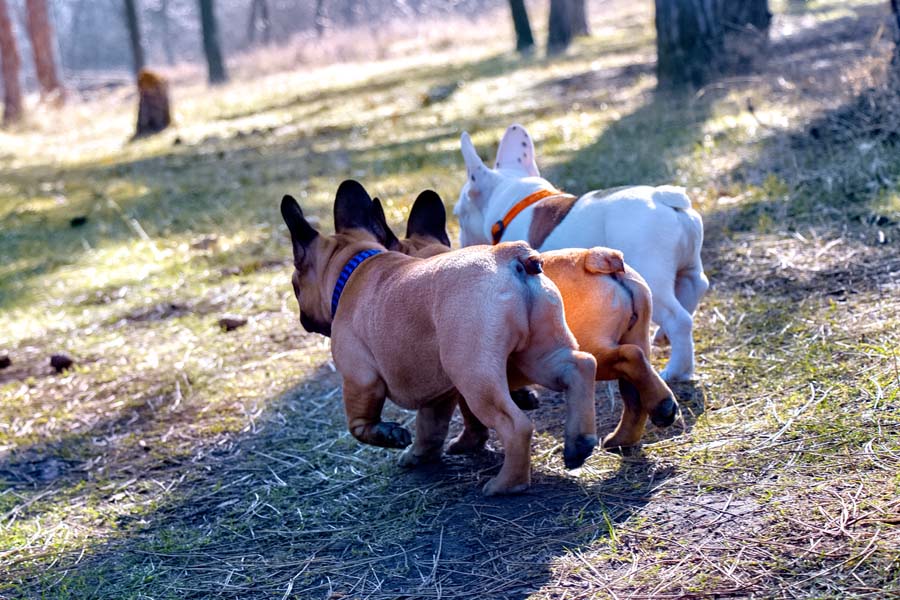A Turramurra Vet Pet Care Article
What do I Need to Know about my Dog’s Anal Glands?

What do I Need to Know about my Dog’s Anal Glands?
by Dr Gretta Howard, Senior Veterinarian
What are anal glands?
Dogs have two pea-sized glands just inside their bottom on either side called anal glands or anal sacs. They are used in wild dogs to mark their scent but domestic dogs have retained these glands.
When your dog produces a solid bowel motion, the glands may be naturally expressed, but sometimes these glands can become blocked and impacted, causing discomfort, commonly leading to infection and the formation of an abscess (pocket of pus). If the anal glands become impacted, they enlarge, making it difficult to pass a bowel motion in some cases.
Some dogs express their anal glands naturally as a fear response when they are anxious. Other dogs may leak a discharge from their anal glands, which can be unhygienic. Owners may notice a horrible off-fish smell which tends to linger.
Many dog owners don’t know they are there until they start scooting their bottom along the carpet, sometimes leaving a dirty streak! This usually occurs when you have visitors or relatives around after you have been telling everyone how wonderful your dog’s behaviour is.
What is scooting?
Your dog may occasionally pull themselves forward using their forelimbs with their bottom on the floor. This action of scooting is often mistaken for an intestinal worm infestation and then deworm their dog. While scooting may be a sign of worms, if your dog is up-to-date with their deworming tablets, the more likely cause is impacted anal glands and it’s time for a vet visit to have them examined and expressed. Not all dogs drag their bottoms when they have an anal gland problem. Another common sign is excessive licking of the anus. If your dog is scooting or excessively licking, then make sure you have your dog’s anal glands examined by a vet.
Can the anal glands get infected?
It is very common for dogs to get an anal gland abscess. This is where an infection within the gland causes it to fill with pus and become swollen and painful. In order to drain out, sometimes the abscess bursts through the skin just below and to one side of the anus. This usually appears as a small hole in the skin with a bloody or yellow discharge. In these circumstances, the dog may require a general anaesthetic to allow the gland to be thoroughly flushed of the infection and occasionally the placement of a temporary surgical drain. Your dog will then require an antibiotic course and pain relief to recover.
Can dogs get anal gland cancer?
Cancer of the anal glands, also known as Apocrine Gland Anal Sac Adenocarcinoma (AGASAC) is particularly aggressive and unfortunately can remain undetected as the tumour grows internally and spreads to the local lymph nodes and beyond. Anal gland cancer usually occurs in older dogs, with the average age of onset is 10.8 years of age. For this reason, our practice recommends that dogs aged over 5 years old should have a rectal exam (if tolerated) at least annually to examine the anal glands. The aim is to detect these tumours when they are small and before they spread elsewhere, which can be fatal.
If detected early, this disease is potentially curable with surgery and those dogs can go on to live a normal life span.
How can I prevent anal gland issues in my dog?
- Anal gland expression
If your dog is scooting or licking the anal area excessively, ask your vet to express your dog’s anal glands. It might not be a vet’s favourite part of the job, but at the same time, a necessity to provide some relief to dogs. This also gives your vet a chance to properly examine the anal glands to ensure there are no lumps or bumps present. - A consistent and high quality diet
With a healthy diet that is suitable for your dog, he or she should be producing firm, well-formed ‘kickable’ faeces with a fairly solid consistency. If your dog’s faeces are firm, then the anal glands are more likely to be cleared naturally when your dog empties their bowels. If your dog is currently producing soft, moist faeces, then trial a premium dry food diet and avoid feeding rich foods to your dog. Some dogs with consistently soft faeces and anal gland issues actually have a food intolerance and need to be placed on a food elimination diet trial. This process should be discussed during consultation with your vet.
How do vets express dog anal glands?
To thoroughly examine and express your dog’s anal glands, a rectal examination by a veterinarian is required. Most dogs tolerate this really well when rewarded with a treat. If you suspect your dog may have an anal gland issue, then book an appointment with one of the vets for anal gland expression. A full consultation is recommended for any first time problems, but for subsequent visits if the vet is expressing the anal glands only, with no other health problems to discuss, then you can make a short consultation for anal gland expression at a reduced fee. The procedure for anal gland expression takes approximately 5 minutes. Your dog will be taken into a larger well-ventilated treatment area and the glands are expressed via a rectal exam (with gloves of course!). This will usually provide some immediately relief if your dog has impacted anal glands. After anal glands are expressed, your dog’s bottom will be cleaned. In some cases, your dog may need to have some hair around the bottom trimmed.
Is anal gland expression painful for my dog?
Generally, while it may not be your dog’s favourite activity at the vet, anal gland expression is not painful. If one of the glands is enlarged and painful, this is a red flag that an anal gland abscess (infection) is present. Occasionally if the anal gland discharge is very thick, expressing the anal glands is very difficult and sedation may be required.
How often should anal glands be expressed?
In dogs that are prone to anal gland problems, bringing them in every 3 months is usually sufficient, although in dogs only occasionally getting problems, then you can bring him or her in when signs of scooting or licking are seen.
What happens if my dog continues to scoot after the anal glands have just been expressed?
Sometimes dogs will scoot or lick their nether regions for another reason, such as:
- Allergic skin disease
- Food intolerance
- Yeast infection
- Urinary tract infection (female dogs licking their vulva may be misinterpreted as licking their anus)
- Flea allergy dermatitis
If your dog continues to show clinical signs after having the anal glands examined and expressed, then a recheck appointment should be arranged. Your vet may initially prescribe some corticosteroid cream or ointment to apply to the anus to see if this resolves the issue. Sometimes further investigations are required such a food elimination diet trial, urine testing and a therapeutic trial with some anti-inflammatory or anti-itch medication.
Can I have my dog’s anal glands removed?
In some cases, where a dog is consistently getting problems involving the anal glands, or if a tumour is detected, surgery under general anaesthesia to remove the anal glands can be performed. This is known as anal sacculectomy. This tends to be a last resort if the first two options listed have failed to get the problem under control, as the surgery can occasionally cause side effects which include faecal incontinence. Usually, faecal incontinence is short-lived post-operatively but in some rare cases it can be permanent. For this reason, we look at the risks and the benefits and recommend this surgery only to dogs that need it.

